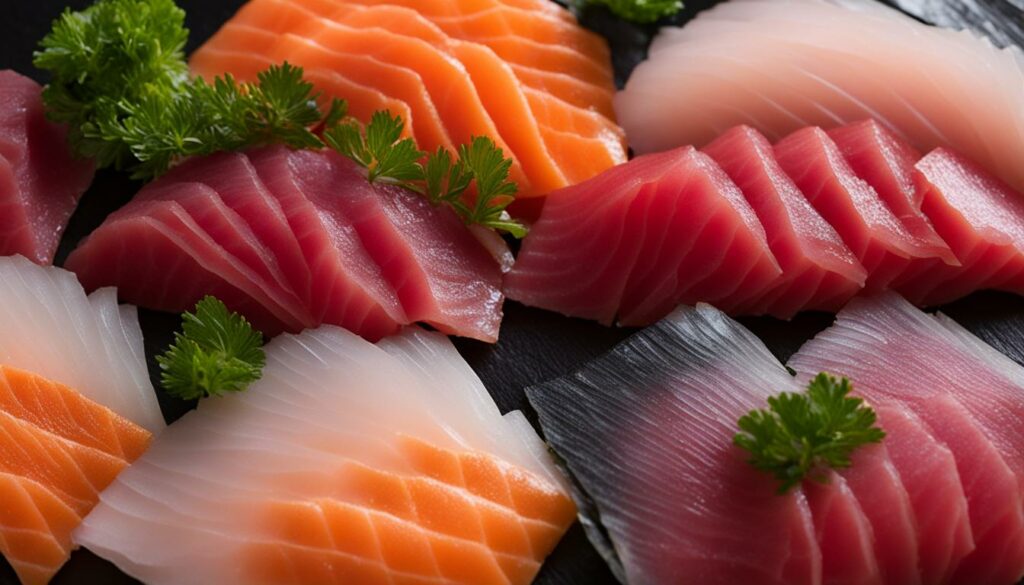Welcome to our guide on sashimi flavor profiles! Sashimi is a traditional Japanese dish known for its delicate and fresh taste. If you’re curious about what sashimi tastes like and want to explore its flavor nuances, you’ve come to the right place.
Sashimi is typically made with raw thinly sliced fish or seafood. The taste of sashimi can vary depending on the type of fish or seafood used, offering a unique sensory experience for your palate. Let’s dive into the flavor profile of sashimi and discover what makes it so delicious!
Key Takeaways:
- Sashimi is a traditional Japanese dish consisting of raw thinly sliced fish or seafood.
- The taste of sashimi is often described as fresh, delicate, and subtly sweet.
- Sashimi offers a combination of salty, sweet, sour, and umami flavors.
- The fishy flavor is present but not overpowering in sashimi.
- Sashimi provides a unique sensory experience with its tender texture and clean, refreshing taste.
Traditional Japanese Sashimi: A Time-Honored Practice
Sashimi holds deep roots in Japanese culinary tradition and has been celebrated for centuries. With origins dating back to 500 BCE and influenced by China, sashimi has become an integral part of Japanese culture and cuisine. The term “sashimi” translates to “cut body” in Japanese, referring to thinly sliced raw fish and seafood. While sashimi can include various meats, the focus is primarily on fish and seafood delicately prepared into bite-sized pieces. It is commonly enjoyed as a standalone dish or served as part of a larger multi-course meal.
“Sashimi embodies the essence of Japanese gastronomy, showcasing the purity and uniqueness of each ingredient, while honoring the ancient art of preparation.”
The Rich History of Sashimi
The history of sashimi can be traced back to ancient Japan, where fishermen would consume freshly caught fish without cooking it to preserve its natural flavors. Over time, this practice evolved, and sushi chefs started meticulously slicing the fish into delicate pieces to enhance its taste and presentation. As Japanese cuisine gained prominence, sashimi became synonymous with traditional Japanese dining, admired for its simplicity and reverence for the ingredients.
Raw Fish in Japanese Cuisine
Raw fish has been an essential component of Japanese cuisine for centuries. The Japanese deeply appreciate the natural flavors and textures of fresh seafood, believing it provides a more authentic and immersive dining experience. Through their precise knife skills and meticulous techniques, sushi chefs transform raw fish into a culinary masterpiece, allowing diners to savor its pure essence. This dedication to raw fish in Japanese cuisine is what sets sashimi apart and elevates it to a revered delicacy.
The Artistry of Sashimi Preparation
Preparing sashimi requires exceptional skill and precision. Sushi chefs carefully select the highest quality fish and seafood, ensuring its freshness and taste. With a swift and precise hand, they make clean cuts, ensuring the perfect thickness and texture for each slice. The result is a visually stunning dish that showcases the beauty of the raw ingredients. This meticulous attention to detail illustrates the artistry and craftsmanship behind sashimi preparation.
| Sashimi | Origin |
|---|---|
| Maguro (Tuna) | Japan |
| Sake (Salmon) | Japan |
| Hirame (Flounder) | Japan |
| Mebachi (Bigeye Tuna) | Japan |
Experience the time-honored practice of traditional Japanese sashimi, a celebration of raw fish in its purest form. Explore the delicate flavors, textures, and artistry that make sashimi an extraordinary culinary experience.
Variety of Sashimi: Exploring Different Flavors
Sashimi offers a wide variety of choices, enabling diners to experience a range of flavors. Some popular types of sashimi fish include:
- Katsuo (Bonito / Skipjack Tuna): It is often lightly seared and served with ponzu citrus and garlic or ginger.
- Sake (Salmon): Salmon sashimi is known for its bright orange color and can range from lean to fattier pieces.
- Maguro (Bluefin Tuna): Bluefin tuna is highly valued globally and is often served in different cuts, including lean tuna (akami), medium fatty tuna (chutoro), and fatty tuna (otoro).
- Ebi (Sweet Shrimp / Prawns): Sweet shrimp, including amaebi and botan ebi, and other varieties like aka ebi and kuruma ebi, offer a sweetness and delicate texture.
- Hokkigai, Akagai, Tsubugai, Mirugai (Surf Clam, Red Clam, Whelk, Geoduck Clam): These clams provide meaty textures and unique flavors, ranging from mild to slightly crunchy.
- Ika (Squid): Squid is often julienned into thin slivers, presenting a visually appealing presentation.
- Hamachi / Kanpachi (Yellowtail): Yellowtail is a lean and creamy fish that offers a milder taste, coming into season during the early summer.
- Tai/Kamachi/Hamadai (Red Snapper/Sea Bream): Red snapper is highly prized in Japan for its excellent flavor, texture, and color, often associated with celebration and good luck.
- Sanma (Pacific Saury/Mackerel): Sanma is enjoyed with grated ginger and thinly sliced myoga or green onion, often served with a small amount of soy sauce and wasabi.
- Suzuki (Sea Bass): Sea bass offers a mild and delicious flavor, with the meat on the back being firm and the belly portion being soft and fatty.
Each type of sashimi brings its unique flavor characteristics and tasting experience.

The Elements of Sashimi Flavor: Breaking It Down
The flavor of sashimi is a delightful combination of different taste elements that work together to create a unique and satisfying dining experience.
Salty Flavor in Sashimi
One of the key elements that contribute to the flavor of sashimi is its salty taste. This comes from the soy sauce that is commonly served as a condiment alongside sashimi. The salty flavor enhances the umami taste of the fish or seafood, adding depth and richness to each bite.
Sweet Taste in Sashimi
In addition to the salty element, sashimi also offers a subtle sweetness that complements the natural sweetness of the fish or seafood. This sweetness comes from the seasoned sushi rice, which is lightly sweetened with sugar. The combination of sweet and savory flavors creates a well-balanced taste profile that is both refreshing and satisfying.
Umami in Sashimi
Umami, often described as the fifth taste, is a savory flavor that is naturally present in sashimi. It is a result of the quality and freshness of the fish or seafood used. The umami taste adds a rich and satisfying dimension to the overall flavor profile of sashimi, making it a truly indulgent culinary experience.
Sourness in Sashimi
To complement the other taste elements, sashimi also incorporates a touch of sourness. This sourness comes from the vinegar used to season the sushi rice. The tangy and refreshing taste of the vinegar adds brightness to the overall flavor profile, balancing the richness of the fish or seafood and enhancing the overall taste experience.
By carefully combining these taste elements – the salty flavor, the sweet taste, the umami richness, and the subtle sourness – sashimi delivers a flavor profile that is both complex and harmonious, tantalizing the taste buds with every bite.

| Taste Element | Description |
|---|---|
| Salty | Soy sauce adds a salty flavor that enhances the umami taste of the fish or seafood. |
| Sweet | Sashimi rice is lightly sweetened, complementing the natural sweetness of the fish or seafood. |
| Umami | The quality and freshness of the fish or seafood contribute to the savory umami taste in sashimi. |
| Sour | Vinegar used to season the sushi rice adds a tangy and refreshing sourness to sashimi. |
The Role of Ingredients in Sushi: Creating the Flavor
The ingredients used in sushi play a crucial role in creating its unique flavor. Different components come together to form the harmonious taste that sushi enthusiasts love.
The Importance of Rice
Sushi rice, seasoned with vinegar, sugar, and salt, plays a fundamental role in sushi’s flavor. The rice provides a slightly sour taste that balances the flavors of the other ingredients. It acts as a neutral canvas, allowing the delicate flavors of the fish, seafood, vegetables, and condiments to shine.
The Freshness Factor in Sashimi
Freshness is paramount when it comes to sashimi. The quality and freshness of the fish and seafood used greatly impact its flavor. Only the freshest ingredients can deliver the delicate and clean taste that is associated with sashimi. The flavors are vibrant, the textures are tender, and the overall experience is unparalleled.
The Role of Condiments
Condiments are an essential component of the sushi experience, enhancing the flavors and elevating the taste. Soy sauce, wasabi, and pickled ginger are commonly served condiments alongside sashimi. Soy sauce adds a savory and salty element, complementing the natural sweetness of the fish or seafood. Wasabi brings a spicy kick and a hint of freshness, while pickled ginger adds a tangy and palate-cleansing touch.
| Sushi Ingredient | Role |
|---|---|
| Rice | Provides a slightly sour taste that balances flavors |
| Fish and Seafood | Delivers freshness and delicate flavors |
| Vegetables and Fruits | Adds texture and flavor |
| Condiments | Enhance flavors and provide depth |
Each ingredient in sushi has its distinct role, contributing to the overall flavor profile. The combination of these ingredients, carefully prepared and expertly presented, creates a culinary experience that is both delicious and satisfying.
Taste Exploration: Different Types of Sushi and Their Flavors
Different types of sushi offer distinct flavors and tastes. Let’s explore the flavors of each type:
Maki Sushi:
Maki sushi has a refreshing and light taste, with the flavors of the ingredients coming together in each bite.
Nigiri Sushi:
Nigiri sushi has a rich and savory taste, with the fresh fish or seafood topping enhancing the flavor of the sushi rice.
Temaki Sushi:
Temaki sushi has a crunchy and refreshing taste, with the flavors of the ingredients combining in a hand-held cone shape.
Chirashi Sushi:
Chirashi sushi has a refreshing and light taste, with the various toppings providing a burst of flavors.
Inari Sushi:
Inari sushi has a sweet and savory taste, with the fried tofu pouches enclosing the flavorful sushi rice.
Each type of sushi offers a unique flavor experience, catering to different preferences.
| Sushi Type | Flavor |
|---|---|
| Maki Sushi | Refreshing and light |
| Nigiri Sushi | Rich and savory |
| Temaki Sushi | Crunchy and refreshing |
| Chirashi Sushi | Refreshing with burst of flavors |
| Inari Sushi | Sweet and savory |
“Each bite of maki sushi encapsulates a refreshing and light taste that leaves you craving for more.” – Sushi enthusiast
The Sashimi Taste Experience: A Delicate and Harmonious Delight
Eating sashimi is a sensory experience that combines the tantalizing taste and enticing texture of this traditional Japanese dish. Sashimi offers a unique combination of flavors and textures, creating a delicate and harmonious delight that is truly unforgettable.
Taste
Sashimi showcases the freshness and quality of the fish or seafood, allowing its natural flavors to shine through. Each bite offers a balance of **salty**, **sweet**, **sour**, and **umami** tastes that dance on your taste buds.
The sashimi taste experience begins with a hint of **saltiness** that is subtly enhanced by condiments like soy sauce. The briny notes of the fish or seafood are complemented by a delicate **sweetness**, not overpowering but just enough to add depth to the flavor profile.
The addition of a touch of **sourness** from vinegar-infused rice brings a refreshing tang to the palate, awakening your senses. Finally, the hallmark of sashimi is its umami richness, derived from the pristine quality and freshness of the ingredients. This savory taste adds a satisfying depth to each piece of sashimi.
Texture
Beyond taste, the texture of sashimi is a key element of its sensory allure. Sashimi is thinly sliced, resulting in a tender and smooth texture that melts in your mouth. The delicate slices of fish or seafood provide a satisfying bite, with each piece offering a delightful contrast to the flavors you experience.
Whether it’s the buttery softness of fatty tuna or the delicate firmness of shrimp, the texture of sashimi adds to the overall enjoyment of the dish. The delicate slices allow you to savor the flavors as they seamlessly blend with the soft and tender texture, creating a truly memorable culinary experience.
Sensory Experience
The sashimi tasting experience is not just about taste and texture; it’s about the complete sensory journey. When served, sashimi is often presented on a platter, artfully arranged with garnishes, adding visual appeal to the dish.
“Sashimi is a feast for the eyes as well as the taste buds. The vibrant colors of the fish and seafood, along with the artful presentation, create an enticing visual spectacle.”
As you take in the visually striking display, the enticing aroma of the fish or seafood lingers in the air, further heightening your anticipation. The different textures of the sashimi, from smooth to slightly firm, offer a tactile experience that enhances the overall enjoyment of each bite.
Combined, these sensory elements come together to create a truly delightful dining experience. The delicate taste, the tantalizing texture, and the encompassing sensory journey make sashimi a dish that appeals to both the palate and the senses.
Conclusion
In conclusion, sashimi offers a unique flavor profile that combines the freshness of raw fish or seafood with delicate and harmonious tastes. The taste of sashimi can vary depending on the type of fish or seafood used, but it is often described as fresh, subtly sweet, and balanced with salty, sour, and umami elements.
The ingredients used in sushi, including rice, fish or seafood, vegetables, and condiments, each contribute to the overall flavor profile. The combination of these elements creates a sensory experience that is both satisfying and enjoyable.
Whether you’re a sushi beginner or a sushi lover, exploring the various types of sushi and experiencing the taste and texture of sashimi can be a truly delightful culinary adventure. So, why not immerse yourself in the world of sashimi and discover the wonderful flavors it has to offer?
FAQ
What does sashimi taste like?
Sashimi has a fresh, delicate, and subtly sweet taste. It offers a combination of salty, sweet, sour, and umami flavors without an overpowering fishy taste.
What is the flavor profile of sashimi?
The flavor profile of sashimi includes salty, sweet, sour, and umami elements. The taste is balanced and harmonious, with each element complementing the others.
How would you describe the texture of sashimi?
Sashimi has a tender and smooth texture. The thinly sliced fish or seafood melts in your mouth and offers a satisfying bite.
What is the sashimi taste experience like?
The sashimi taste experience is a unique sensory delight. It combines the flavors of the fish or seafood with the tender texture, creating a harmonious and enjoyable dining experience.
What are the flavor characteristics of sashimi?
Sashimi offers a balance of flavors, including freshness, subtlety, and a combination of salty, sweet, sour, and umami tastes. The fish or seafood used in sashimi greatly contributes to its unique flavor characteristics.
Can you provide some sashimi tasting notes?
Sashimi tasting notes may vary depending on the type of fish or seafood, but they often include descriptors such as fresh, delicate, subtly sweet, tender, and clean. The flavors are well-balanced and harmonious.
What are some popular types of sashimi fish?
Some popular types of sashimi fish include katsuo (bonito/skipjack tuna), sake (salmon), maguro (bluefin tuna), ebi (sweet shrimp/prawns), hokkigai (surf clam), akagai (red clam), tsubugai (whelk), mirugai (geoduck clam), ika (squid), hamachi/kanpachi (yellowtail), tai/kamachi/hamadai (red snapper/sea bream), sanma (pacific saury/mackerel), and suzuki (sea bass).
How does the taste of sashimi differ for different types of fish?
The taste of sashimi can vary depending on the type of fish. For example, katsuo (bonito) may have a lightly seared flavor, salmon is known for its bright orange color and can range from lean to fatty pieces, and bluefin tuna can be served in different cuts with varying fat content. Each fish offers its unique taste and texture.
What are the key flavor elements in sashimi?
The key flavor elements in sashimi include salty, sweet, sour, and umami tastes. The soy sauce adds a salty flavor, the sushi rice provides a slight sweetness, the vinegar in the rice adds a tangy element, and the freshness of the fish or seafood contributes to the umami flavor.
How does the freshness of the fish or seafood impact the taste of sashimi?
The freshness of the fish or seafood is crucial in achieving the delicate and clean taste associated with sashimi. Fresh ingredients enhance the overall flavor and texture, ensuring a higher-quality dining experience.
What role do condiments play in sashimi flavor?
Condiments such as soy sauce, wasabi, and pickled ginger enhance the flavors of sashimi. Soy sauce adds a salty note, wasabi provides a hint of spiciness, and pickled ginger offers a tangy and refreshing element that complements the fish or seafood.
What is the role of rice in creating the flavor of sushi?
Rice plays a crucial role in sushi flavor as it is seasoned with vinegar, sugar, and salt. It provides a slightly sour taste that balances the flavors of the other ingredients, creating a harmonious flavor profile.
How do different types of sushi taste?
Maki sushi has a refreshing and light taste, nigiri sushi has a rich and savory flavor, temaki sushi offers a crunchy and refreshing taste, chirashi sushi has a refreshing taste with various toppings, and inari sushi has a sweet and savory flavor with the fried tofu pouches enclosing the flavorful sushi rice.
What is the taste and texture of sashimi like?
Sashimi offers a unique taste experience with its fresh, delicate, and balanced flavors. The texture is tender and smooth, allowing the flavors to melt in your mouth. The thinly sliced fish or seafood provides a satisfying bite.



